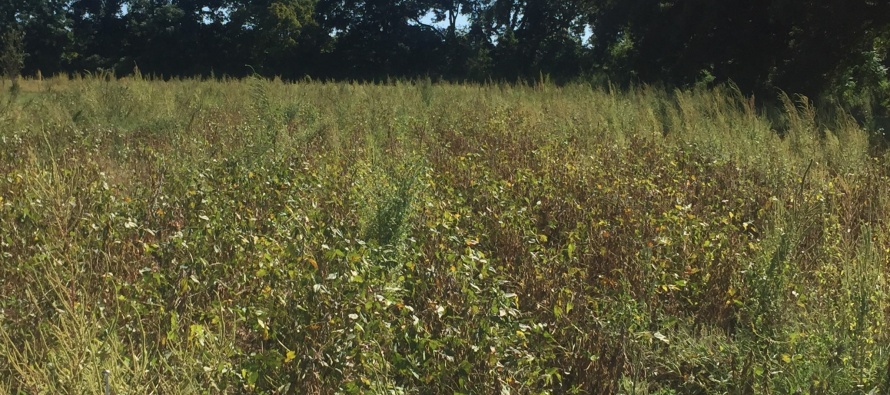Managing PPO-resistant Palmer Amaranth in Mississippi Soybean

Related Articles
- 2010 Soybean And Corn Variety Trial Data 3
- Flag The Technology 0
- 2011 Rice Burndown Considerations 0
Latest Tweets
The protoporhyrinogen oxidase (PPO) herbicides (herbicide Group 14) have been one of the primary herbicide chemistries for control of Palmer amaranth in Mississippi soybean over the last six to eight years. Based on greenhouse screening, fields located in Bolivar, Coahoma, Sunflower, and Tunica counties or in counties adjacent to these likely contain Palmer amaranth resistant to PPO herbicides. The presence of PPO-resistant Palmer amaranth will complicate herbicide programs in affected areas. Most populations of Palmer amaranth in the Mississippi Delta exhibit multiple resistance to glyphosate and ALS herbicides (herbicide Group 2; Classic, Envoke, Regiment, Staple).
Suggested herbicide programs (Information Sheet 2022) in Mississippi soybean have been updated to address multiple resistance to glyphosate, ALS, and/or PPO herbicides in Palmer amaranth. PPO herbicides are still a prominent part of this program. Residual applications of PPO herbicides still offer some control of PPO-resistant waterhemp (a pigweed species closely related to Palmer amaranth) in midwestern states. However, the level of control and length of residual is lower on resistant compared with susceptible populations. Preliminary data from the University of Arkansas shows a similar response in PPO-resistant Palmer amaranth. Therefore, the use of herbicide mixtures containing multiple effective modes of action is critical in areas with PPO-resistant Palmer amaranth.
The updated herbicide programs for managing multiple resistant Palmer amaranth in Mississippi soybean include a preplant application 14 to 21 days prior to planting and after final bed preparation in fields with targeted planting date later than April 15. This application should contain paraquat at 0.75 lb active ingredient/acre to control Palmer amaranth emerged at application.
All herbicide mixtures suggested for use in the preplant timing include a residual PPO herbicide plus a herbicide representing Group 15. Herbicides in Group 15 are very long chain fatty acid synthesis inhibitors (VLCFAs), and those recommended for use in Mississippi soybean include metolachlor or S-metolachlor, Warrant, Zidua, and the Anthem brand of products (Caution: Warrant should be applied when temperatures are warm, as colder weather may reduce activity due to encapsulation degradation kinetics.).
Regardless of targeted soybean planting dates, preemergence applications should be made before soybean emergence up to 7 days prior to planting. As with the preplant, preemergence applications should contain paraquat at 0.75 lb active ingredient/acre. Herbicide mixtures suggested for use in the preemergence timing include metribuzin and a Group 15 herbicide. Some soybean varieties are susceptible to injury from metribuzin. Furthermore, soil pH and texture directly influence metribuzin activity. Soil test results along with seed and herbicide manufacturer information should be consulted to ensure the correct combination of variety and metribuzin rate.
Postemergence herbicide applications should be made 7 to 21 days after soybean planting with precise timing dictated by efficacy of preplant and/or preemergence treatments, soybean growth rate, and environmental conditions. Earlier applications should be utilized if previous treatments were not incorporated or when temperatures are warm and soybean and/or existing weeds are growing rapidly.
Herbicide mixtures suggested for postemergence use in the Roundup Ready system include glyphosate, fomesafen, and a Group 15 herbicide. In Mississippi counties with known populations of glyphosate- and/or PPO-resistant Palmer amaranth or in areas where unexplained herbicide failures occurred in 2015, postemergence herbicide applications should be timed earlier because efficacy on emerged Palmer amaranth will likely be poor and the residual activity of the herbicide mixture should be utilized to prevent new emergence.
The only postemergence herbicide that controls multiple resistant Palmer amaranth after crop emergence is Liberty 280 (herbicide Group 10). Liberty 280 may only be applied to LibertyLink soybean varieties. It is primarily a contact herbicide, so weed size at application, application volume, nozzle selection, and time of day of application are all critical to optimize herbicide performance. Liberty 280 applications should target Palmar amaranth seedlings no greater than 3 to 4 inches in height.
Addressing issues with multiple resistant Palmer amaranth requires development of sound “weed management” programs and not just attempts at “weed control” with herbicides. Scouting fields is critical. Check closely for efficacy following all herbicide applications so appropriate decisions can be made quickly. Use all possible tactics to combat Palmer amaranth. Cultural practices such as variety selection, row spacing, planting date, hand-weeding, etc. are critical, especially as the number of effective herbicides continues to decline. These strategies also assist in managing the weed soil seedbank. The soil seedbank is the key to the Palmer amaranth problem. If it is not managed, Palmer amaranth WILL get worse.
Managing Palmer amaranth with multiple resistance to glyphosate, ALS, and PPO herbicides in Mississippi soybean will be complicated; however, control of this species is still feasible. Please contact me if you suspect a problem.






Let me tell You a sad story ! There are no comments yet, but You can be first one to comment this article.
Write a comment